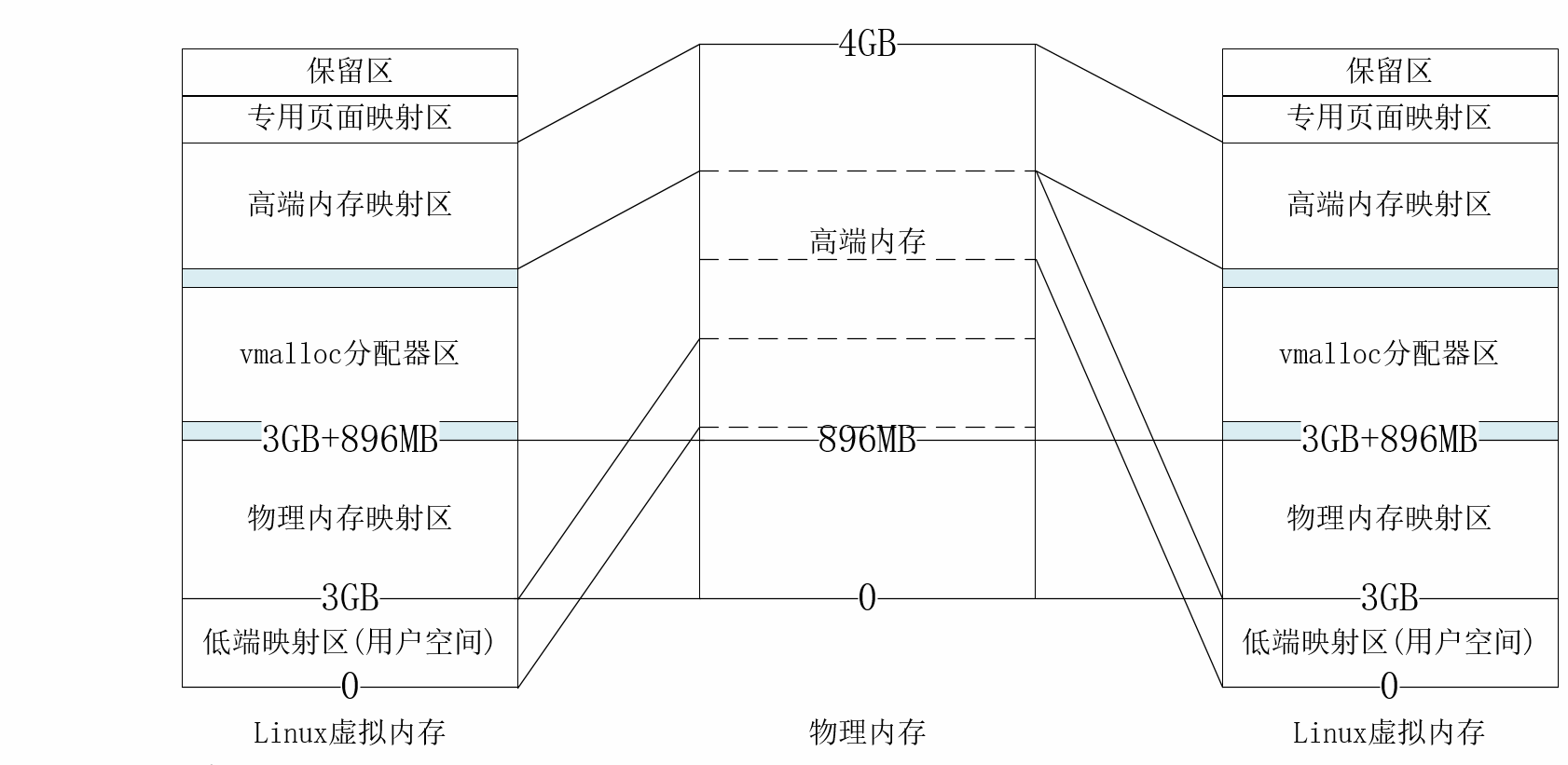Rumah >Tutorial sistem >LINUX >Teknologi aplikasi memori dalam pemacu Linux: prinsip dan kaedah
Teknologi aplikasi memori dalam pemacu Linux: prinsip dan kaedah
- WBOYWBOYWBOYWBOYWBOYWBOYWBOYWBOYWBOYWBOYWBOYWBOYWBke hadapan
- 2024-02-12 09:45:221256semak imbas
Memori ialah salah satu sumber terpenting dalam sistem Linux Ia boleh digunakan untuk menyimpan data, kod, tindanan, dll. Aplikasi dan pelepasan memori adalah salah satu operasi paling asas dalam pembangunan pemacu Linux Ia melibatkan konsep seperti ruang kernel dan ruang pengguna, peruntukan statik dan peruntukan dinamik, memori berterusan dan memori tidak bersempadan. Dalam artikel ini, kami akan memperkenalkan teknologi aplikasi memori dalam pemacu Linux, termasuk kmalloc, vmalloc, get_free_pages, dma_alloc_coherent dan fungsi lain, dan memberi contoh untuk menggambarkan penggunaan dan langkah berjaga-jaganya.

Mari kita mulakan dengan asas-asas Gambar di bawah ialah model pemetaan memori Linux
- Setiap proses mempunyai ruang proses sendiri 0-3G ruang proses adalah ruang pengguna, dan 3G-4G adalah ruang kernel .
- Ruang pengguna setiap proses tidak berada dalam halaman memori fizikal yang sama, tetapi ruang kernel semua proses sepadan dengan alamat fizikal yang sama
- Alamat yang diperuntukkan oleh vmalloc boleh menjadi memori mewah atau memori rendah
- Alamat fizikal 0-896MB dipetakan secara linear ke kawasan pemetaan fizikal.
“
”
Aplikasi dinamik memori
Seperti lapisan aplikasi, program kernel juga perlu memperuntukkan memori secara dinamik Perbezaannya ialah proses kernel boleh mengawal sama ada memori yang diperuntukkan berada dalam ruang pengguna atau ruang kernel boleh digunakan untuk memperuntukkan memori ke kawasan timbunan ruang pengguna, cth, pengguna Malloc ruang pengguna proses akhirnya akan memanggil semula fungsi peruntukan memori ruang kernel melalui panggilan sistem Pada masa ini, fungsi peruntukan memori adalah milik proses pengguna dan boleh memperuntukkan ruang dalam kawasan timbunan proses pengguna dan mengembalikannya, akhirnya menjadikan pengguna Proses memperoleh peruntukan memori dalam ruang penggunanya sendiri hanya diperuntukkan dalam ruang kernel, jadi proses pengguna tidak boleh mengakses ruang secara langsung; jadi ia kebanyakannya digunakan untuk memenuhi keperluan memori program kernel itu sendiri Berikut ialah API biasa untuk memori aplikasi ruang kernel Linux:
kmalloc – kfree
Memori yang diminta oleh kmalloc adalah berterusan dalam ingatan fizikal Mereka hanya mempunyai offset tetap dari alamat fizikal sebenar, jadi terdapat hubungan penukaran yang mudah. API ini kebanyakannya digunakan untuk memohon memori yang bersaiz kurang daripada satu halaman. Lapisan bawah kmalloc perlu memanggil **__get_free_pages Bendera gtp_t yang menunjukkan jenis memori dalam parameter ialah singkatan bagi jenis memori yang biasa digunakan termasuk GFP_USER, GFP_KERNEL, GFP_ATOMIC**.
- GFP_USER
- bermaksud memperuntukkan memori untuk halaman ruang pengguna dan boleh disekat; GFP_KERNEL
- ialah bendera yang paling biasa digunakan Ambil perhatian bahawa apabila menggunakan bendera ini untuk memohon ingatan, jika ia tidak dapat dipenuhi buat sementara waktu, ia akan menyebabkan penyekatan proses, tidak boleh digunakan dalam konteks bukan proses seperti pemprosesan gangguan fungsi, tasklet dan pemasa kernel. ! ! GFP_ATOMIC
- boleh digunakan dalam tiga senario di atas Bendera ini menunjukkan bahawa jika memori yang diminta tidak boleh digunakan, ia akan kembali serta-merta. rreeee Siri API yang sama juga tersedia
/** * kmalloc - allocate memory * @size: how many bytes of memory are required. * @flags: the type of memory to allocate. * The @flags argument may be one of: * %GFP_USER - Allocate memory on behalf of user. May sleep. * %GFP_KERNEL - Allocate normal kernel ram. May sleep. * %GFP_ATOMIC - Allocation will not sleep. May use emergency pools. * * For example, use this inside interrupt handlers. */ void *kmalloc(size_t size, gfp_t flags); /** * kfree - free previously allocated memory * @objp: pointer returned by kmalloc. * If @objp is NULL, no operation is performed. */ void kfree(const void *objp);__dapatkan_halaman_percuma – halaman_percuma
. PAGE_SIZE digunakan untuk mengurus memori, jadi mereka
sentiasa memperuntukkan memori dalam unit halaman**
void *kzalloc(size_t size, gfp_t flags)Siri API yang sama juga tersedia
unsigned long __get_free_page(gfp_t gfp) unsigned long get_zeroed_page(gfp_t gfp_mask) struct page *alloc_pages(gfp_t gfp_mask, unsigned int order) void free_page(unsigned long addr)
vmalloc – vfree
vmalloc在虚拟内存空间给出一块连续的内存区,实质上,这片连续的虚拟内存在物理内存中并不一定连续,所以vmalloc申请的虚拟内存和物理内存之间也就没有简单的换算关系,正因如此,vmalloc()通常用于分配远大于__get_free_pages()的内存空间,它的实现需要建立新的页表,此外还会调用使用GFP_KERN的kmalloc,so,一定不要在中断处理函数,tasklet和内核定时器等非进程上下文中使用vmalloc!
/** * vmalloc - allocate virtually contiguous memory * @size: allocation size * Allocate enough pages to cover @size from the page level allocator and map them into contiguous kernel virtual space. */ void *vmalloc(unsigned long size) /** * vfree - release memory allocated by vmalloc() * @addr: memory base address */ void vfree(const void *addr)
同系列的API还有
/** * vmalloc_32 - allocate virtually contiguous memory (32bit addressable) * @size: allocation size * Allocate enough 32bit PA addressable pages to cover @size from the page level allocator and map them into contiguous kernel virtual space. */ void *vmalloc_32(unsigned long size)
slab缓存
我们知道,页是内存映射的基本单位,但内核中很多频繁创建的对象所需内存都不到一页,此时如果仍然按照页映射的方式,频繁的进行分配和释放就会造成资源的浪费,同时也会降低系统性能。为了解决的这样的问题,内核引入了slab机制,使对象在前后两次被使用时被分配在同一块内存或同一类内存空间,且保留了基本的数据结构,就可以大大提高效率。kmalloc的底层即是使用slab算法管理分配的内存的。注意,slab依然是以页为单位进行映射,只是映射之后分割这些页为相同的更小的单元,从而节省了内存。slab分配的单元不能小于32B或大于128K。
/** * kmem_cache_create - 创建slab缓存对象 * @name:slab缓存区名字, * @size:slab分配的缓存区的每一个单元的大小 * @align:缓存区内存的对齐方式,一般给0 * @flags:控制分配的位掩码, * %SLAB_POISON - Poison the slab with a known test pattern (a5a5a5a5) to catch references to uninitialised memory. * %SLAB_RED_ZONE - Insert `Red' zones around the allocated memory to check for buffer overruns. * %SLAB_HWCACHE_ALIGN - Align the objects in this cache to a hardware cacheline. This can be beneficial if you're counting cycles as closely as davem. * %SLAB_CACHE_DMA - Use GFP_DMA memory * %SLAB_STORE_USER - Store the last owner for bug hunting *define SLAB_PANIC - Panic if kmem_cache_create() fails */ struct kmem_cache *kmem_cache_create(const char *name, size_t size, size_t align,unsigned long flags, void (*ctor)(void *)) /** * kmem_cache_alloc - Allocate an object from this cache. * @cachep: The cache to allocate from. * @flags: See kmalloc(). * The flags are only relevant if the cache has no available objects. */ void *kmem_cache_alloc(struct kmem_cache *cachep, gfp_t flags) /** * kmem_cache_free - Deallocate an object * @cachep: The cache the allocation was from. * @objp: The previously allocated object. * Free an object which was previously allocated from this cache. */ void kmem_cache_free(struct kmem_cache *cachep, void *objp) void kmem_cache_destroy(struct kmem_cache *s)
范例
//创建slab对象
struct kmem_cache_t *xj_sbcache;
xj_sbcache = kmem_cache_create("xjslab",sizeof(struct xj_unit_t),0,SLAB_CACHE_DMA|SLAB_PANIC,NULL,NULL);
//分配slab缓存
struct xj_unit_t *xj_unit;
xj_unit = kmem_cache_alloc(xj_sbcache,GFP_KERNEL);
/* 使用slab缓存 */
/* 释放slab缓存 */
kmem_cache_free(xj_sbcache, xj_unit);
/* 销毁slab缓存 */
kmem_cache_destroy(xj_sbcache);
内存池
除了slab机制,内核还提供了传统的内存池机制来管理小块内存的分配。内存池主要是用来解决可能出现的内存不足的情况,因为一个内存池在创建的时候就已经分配好了一内存,当我们用mempool_alloc向一个已经创建好的内存池申请申请内存时,该函数首先会尝试回调内存池创建时的分配内存函数,如果已经没有内存可以分配,他就会使用内存池创建时预先分配的内存,这样就可以避免因为无内存分配而陷入休眠,当然,如果预分配的内存也已经使用完毕,还是会陷入休眠。slab机制的目的是提高内存使用率以及内存管理效率,内存池的目的是避免内存的分配失败。下面是内核中提供的关于内存池的API
/** * mempool_create - create a memory pool * @min_nr: the minimum number of elements guaranteed to be allocated for this pool. * @alloc_fn: user-defined element-allocation function. * @free_fn: user-defined element-freeing function. * @pool_data: optional private data available to the user-defined functions. * * this function creates and allocates a guaranteed size, preallocated memory pool. The pool can be used from the mempool_alloc() and mempool_free() functions. * This function might sleep. Both the alloc_fn() and the free_fn() functions might sleep - as long as the mempool_alloc() function is not called from IRQ contexts. */ mempool_t *mempool_create(int min_nr, mempool_alloc_t *alloc_fn, mempool_free_t *free_fn, void *pool_data) /** * mempool_alloc - allocate an element from a specific memory pool * @pool: pointer to the memory pool which was allocated via mempool_create(). * @gfp_mask: the usual allocation bitmask. * this function only sleeps if the alloc_fn() function sleeps or returns NULL. Note that due to preallocation, this function never* fails when called from process contexts. (it might fail if called from an IRQ context.) */ void * mempool_alloc(mempool_t *pool, gfp_t gfp_mask) /** * mempool_free - return an element to the pool. * @element: pool element pointer. * @pool: pointer to the memory pool which was allocated via mempool_create(). * * this function only sleeps if the free_fn() function sleeps. */ void mempool_free(void *element, mempool_t *pool) /** * mempool_destroy - deallocate a memory pool * @pool: pointer to the memory pool which was allocated via mempool_create(). * * Free all reserved elements in @pool and @pool itself. This function only sleeps if the free_fn() function sleeps. */ void mempool_destroy(mempool_t *pool)
通过本文,我们了解了Linux驱动中的内存申请技术,它们各有优缺点和适用场景。我们应该根据实际需求选择合适的函数,并遵循一些基本原则,如匹配申请和释放函数,检查返回值是否为空,避免内存泄漏等。内存申请技术是Linux驱动开发中不可或缺的一部分,它可以保证驱动程序的正常运行和数据交换,也可以提升驱动程序的性能和稳定性。希望本文能够对你有所帮助和启发。
Atas ialah kandungan terperinci Teknologi aplikasi memori dalam pemacu Linux: prinsip dan kaedah. Untuk maklumat lanjut, sila ikut artikel berkaitan lain di laman web China PHP!


